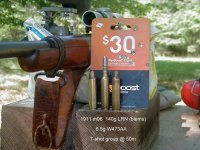Tradition. Cast bullets have been used in revolvers since it was invented, decades before the first semiauto handgun, decades before the first jacketed bullet was created.
The jacketed bullet was probably first used in handguns because of military specs that called for a bullet that could fire hundreds of rounds without lead fouling. Since the semiauto was originally loaded with jacketed bullets both in the famous nine and forty five, tradition was upheld, just like the tradition of using lead in revolvers.
Something else to kick around in your mind, which costs more, a cast lead bullet, or a jacketed bullet? If you are putting jacketed bullets into a round rather than lead, which one will cost more, which round would sell for a higher price? which one will look prettier, more advanced and precise? How many people would buy a dull, nasty looking lead bullet when they can pick up a beautiful copper bullet instead? Don't people all over the world buy copper plated rimfire rounds by the millions, paying a little more for the copper wash than they do the plain lead?
The reason for jacketed and plated bullets in semiauto loads is more about profits than anything else. People are inclined to stay with tradition. They are more inclined to buy better looking products. There are other reasons why people are naturally going to be inclined to buy copper jacketed rounds rather than lead. Yes, the copper jacketed bullet costs more to make than lead, the jacketed bullet ammo costs more to make, but it also can be sold for a premium over lead, and if a jacketed bullet can make even one cent more profit over lead ones, it is worth it. Selling jacketed bullets instead of lead puts millions of dollars gross profits into the industry from the top to bottom.
Have you noticed a trend towards jacketed 130 grain bullets in .38 special? wonder why? because that round is a lot prettier than the 158 lead. People expect it to cost more, and it is priced a little more. They price it a bit higher than lead rounds and collect a slightly higher gross margin on them. Then, there is the slight savings in the cost of making the cores, and in many cases, they are only plated bullets, not traditional cupping and drawn.
Just like almost everything on this planet, if you ask something about a business or product, the answer will almost always be "look at the money." It might not be obvious, but no business survives without profits, and almost everything a business does is intended to increase profits at some level either in the present or in the future.
Amazon went for years without making a profit, and now they are a powerhouse. If the ammo makers and dealers can make just a half cent more per round selling premium products, meaning jacketed bullets, they will. That half cent of extra gross profit is an increase of 1%, right? any company would do anything to boost their gross margin by one percent by just altering the products a bit.



